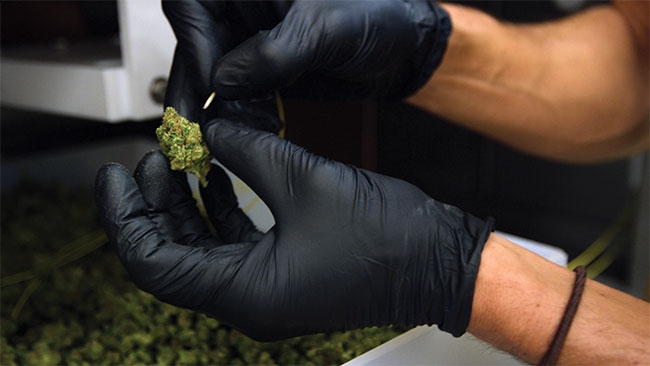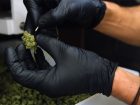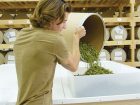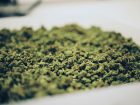
Features
Production
Focus on fungi
Until recently, the craft of growing cannabis has mostly been an underground trade, where the development of growing techniques is largely a private, trial-and-error process. As legalization spreads and cannabis becomes further normalized, cultivators are asking the question: when will cannabis farming be treated like farming?
August 21, 2018 By Ketch DeGabrielle
 Inserting probes into the cannabis flower prior to radio frequency treatment. (Photo credit: Ziel) Until recently
Inserting probes into the cannabis flower prior to radio frequency treatment. (Photo credit: Ziel) Until recentlyToday’s cannabis farmers face immense challenges, including high expenses and excessive regulation. However, as the demand for cannabis grows, so does the number of producers. The best ones are becoming more efficient by investing in better tools, mechanizing tasks, and focusing on consistency and process development. In agriculture, there are machines and process solutions for nearly everything. In cannabis, we are still writing the first chapter.
Cannabis and agriculture
One of the largest disparities between agriculture and cannabis farming is health and safety standards. Federal government structures such as the Food and Drug Administration in the U.S. and The Food and Drugs Act in Canada perform substantial research to determine what is safe and acceptable in food, but in cannabis, these regulations vary based on location. Some areas are required to test for pesticides, yeast, mold, salmonella and so on – while others are not.
In agriculture, processors have consistent methods for treating all of their food products for contaminants prior to release in the market. In many cases, these processes are approved by regulatory agencies as being effective and allow for a systems approach to dealing with yeast, mold, and bacteria issues.
Cannabis cultivators are also working to address these same issues to ensure customer safety and regulatory compliance. It seems only natural that when searching for reliable, long-term solutions for the age-old problems the agricultural industry has faced, some cultivators and cannabis business owners are adopting the same methods.
Regulatory requirements
Similar to the food industry adopting regulatory requirements to deem foods safe for sale, cannabis must also meet regulatory requirements before being sold at a dispensary. Canada and U.S. states, such as Colorado, Nevada, Hawaii, New Mexico and Arizona, have adopted a total yeast and mold count (TYMC) threshold for cultivators to meet with a regulatory limit of 10,000 colony forming units per gram of cannabis (CFU/g). A colony forming unit is the scientific means of counting and reporting the population of living yeast and mold in a product.
To determine TYMC, a cannabis sample is plated on a petri dish and incubated at a specific temperature for three to five days. During this time, the yeast and mold present will grow and reproduce. Each colony, which represents an individual or a group of yeast and mold, produces one spot on the petri dish, which is considered one colony forming unit. Dead mold, dead spores and powdery mildew do not grow in a petri dish and therefore, are not considered CFUs.
It’s important to note that mold by itself is not always considered bad – it is widespread and can be found in the air, water, soil, vegetation and decaying matter. The vast majority of mold and yeast in the environment are harmless and even useful to humans. Due to their versatility, it is rare to find a place or surface that is naturally free of fungi or their spores.
Radio frequency treatment
Radio frequency (RF), a technology long associated with the telecommunications industry, also has a rich history in agriculture for food pasteurization to kill microbial pathogens. Early attempts of using RF for food pasteurization date back to 1947 when RF was tested to extend the storage life of bread loafs. In the years since, many scientists and researchers have conducted experiments to explore the efficacy of RF processing on microbial reduction with a variety of food and agricultural products. Currently, the RF treatment process is used across the globe to ensure safe food products for the masses. Products such as almonds, cashews, hazelnuts, macadamia, Brazil nuts, sesame seeds, and chia seeds have been treated with RF for the past decade, and the RF treatment process received the stringent process validation certificate from the Almond Board of California, as well as USDA organic certification. RF is also used to treat delicate, high-value spices and herbs like vanilla beans and teas.
Radio frequency at 27.12 Mhz is on the lower end of the electromagnetic wave spectrum. At low frequencies, electromagnetic waves are unable to carry adequate energy to alter atomic and molecular structures to “ionize atoms,” making RF a non-ionizing process.
It treats product by exposing it to an electromagnetic field. The molecules containing water reverse their polarity and oscillate at 27 million times a second, generating even, volumetric heat. This generation of friction ruptures the cellular walls of the pathogens and kills them. This process creates sufficient thermal energy strong enough to kill the microorganisms, but low enough not to destroy the sensory characteristics and quality of the product.
Using radio frequency to reduce TYMC is becoming increasingly popular amongst producers in North America. Canadian LPs are moving away from gamma and e-beam, which both use ionizing radiation. As the cannabis industry continues to grow and advance, and consumers become more educated, it is likely that additional markets will adopt some form of TYMC testing as customers demand higher levels of product safety, preferably organic.
Cannabis grow application
Typically, the processing time for a batch of 20 pounds of cannabis using RF is less than 15 minutes, making this option scalable for large cultivators. RF preserves cannabis’ potency, avoids decarboxylation, and has minimal to no impact on the sensory qualities of the product: colour, texture, aroma, and flavor. Most importantly, flower is brought under the 10,000 cfu/g threshold, even with a starting count as high as 150,000 cfu/g.
During my time as the operations manager at Los Sueños Farms, the largest outdoor cannabis farm in the U.S., I spent two years researching yeast and mold remediation methods. There are several methods to effectively kill yeast and mold on finished product, but very few that scale and do not negatively affect quality. Outdoor cannabis farms are subject to a wide range of weather conditions and uncontrolled variables, and while these conditions do not cause cannabis to be inherently moldy, the wind carries spores from surrounding areas, which can cause mold if allowed to germinate.
Secondary contamination from human handling during harvest and trimming for both indoor and outdoor-grown cannabis is also a problem. Every cultivator should strive to dial in growing methods to limit contaminant exposure during cultivation, but oftentimes nature throws a curveball and you must be prepared for the unexpected to remain competitive in a difficult market. Every cultivator should have a finished product remediation plan.
At Los Sueños, our goal was to ensure that all cannabis produced not only met state regulatory requirements, but also offered the safest and cleanest product possible to our customers. For these reasons, we decided on RF as the optimal solution and have incorporated the RF treatment process using technology from Ziel, based in San Francisco, Calif., into our production processes for the past two years with great success. In roughly four weeks, Los Sueños Farms harvests 36,000 plants, so the efficiency and reliability of radio frequency treatment is critical in keeping production on schedule.
As the Canadian cannabis industry experiences immense growth due to impending legalization, it is crucial to implement processes in your grow that will enable you to both provide the safest product to consumers and protect your business.
Ketch DeGabrielle is the owner of Qloris Consulting and Bud Sorter. He is an industrial designer who started his career in the cannabis space by designing harvest and processing systems for Los Sueños Farms in California. Email him at ketch@qloris.com.
Print this page


